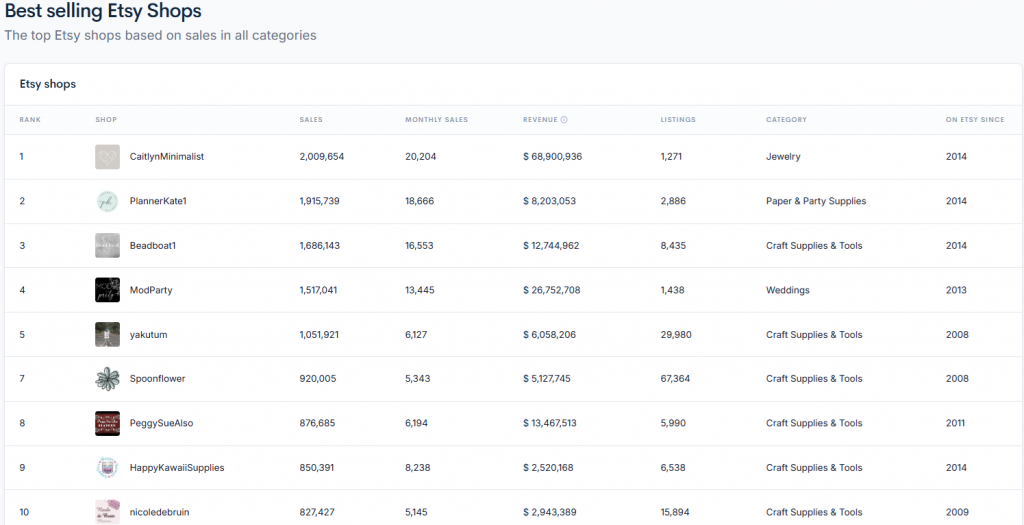How to sell on Etsy: Setting up an Etsy shop

Here at OddsMonkey, we have created useful guides to show you how you can make extra money on the side. If you’re interested in trying to make a few quid on the side, have a look at our Side Hustle Ideas section.
In the meantime, we’ll crack on with explaining what Etsy is and how you can make money on Etsy.
If you’re a crafty person, you may be wondering how to sell on Etsy. If you think people might be willing to pay a bit of money for your handmade creations, then you could stand to make money by setting up an Etsy shop.
This huge online marketplace provides a platform for creative types to sell a huge variety of different products, from clothing and jewellery to homeware.
Whatever your talent, there’s sure to be a way you can use it to make money online, whether thinking about making money on maternity leave or following a passion.
In this guide, we’ll explain how to sell on Etsy, covering:
- What is Etsy?
- How does Etsy work?
- How to make money on Etsy in the UK
- Etsy fees
- How to sell on Etsy
- What to sell on Etsy
- Pros and cons of Etsy
- Selling on Etsy: Tips
What Is Etsy?
Etsy is a global online marketplace that specialises in selling unique, handmade, custom and vintage items. Sellers from around the world can list items in their personal Etsy stores to connect with buyers. More than 16 million brits have a side hustle, and Etsy is a great way for creative people to earn a bit extra on the side.
You can find almost anything handmade or craft-related on Etsy. There’s 15 main categories that items fall into:
- Jewellery
- Accessories
- Clothing
- Shoes
- Home & Living
- Weddings
- Paper & Party Supplies
- Toys & Games
- Art & Collectibles
- Craft Supplies & Tools
- Pet Supplies
- Bags & Purses
- Electronics & Accessories
- Bath & beauty
- Books, Films & Music
Etsy was founded just over 20 years ago in 2005 by 3 gentlemen. One of which was Robert Kalin who was a frustrated woodworker who wanted a space to sell handmade items.
How To Make Money On Etsy In The UK
How much money can you make?
The amount of money you can make from selling on Etsy completely depends on the individual shop. For example, the popularity of your items and store, your prices, the number of orders you complete, and your advertising costs all play a part in how much money you can make.
It’s fair to say the biggest sellers and earners residue in America. Here’s a snapshot of the top 10 Etsy shops in 2025.

Alt text: screenshot of the top 10 best selling etsy shops for 2025
As you can see, some Etsy sellers have made millions in revenue since they began.
Source: Alura
How Much Does It Cost To List On Etsy?
Here’s a breakdown of Etsy seller fees (correct at the time of writing):
- Listing fee = £0.16. All listings are active for four months. Or until they sell. Whichever happens first.
- Transaction fee = 6.5%. Whenever you sell an item, you’ll need to pay a commission.
- Payment processing fee = 4% + £0.20. If you use Etsy’s payment system, you’ll need to pay a standard payment processing fee for each item you sell.
In addition to the above fees, there’s a controversial fee called the Offsite Ads Fee.
This is a touchy subject amongst some Etsy shop owners because it feels like a punishment for their success. Etsy states on its site: “Off-Site advertising is optional for most sellers, but may be required based on how much you make in sales on Etsy in a 12-month period.” Meaning that if you make a lot of sales, they’ll ‘do you a favour’ by advertising your shop even if you don’t want them to.
For example, if a shop has made a lot of sales, they may be running at or close to their capacity in terms of the orders they can take on. However, Etsy will advertise for them, based on their success, and then charge them for the privilege. You’ll pay a fee if you make a sale from an offsite ad.
These are the fees that Etsy apply for Offsite Ads:
- If your Etsy shop makes less than $10,000 in the past 12 months, you’ll be charged 15% for any orders attributed to an Offsite Ad on the amount you made from the sale before the advertising fee was applied.
- If your etsy shop made $10,000+ the fee is reduced to 12%.
Etsy Plus
Etsy Plus is a paid package that promises to help you “jump-start growth” and take your shop “to the next level”. At the time of writing, an Etsy Plus subscription costs $10 a month (approx £7.85). Included in Etsy Plus is:
- 15 credits per month to use on listings and Etsy Ads.
- $5 in Etsy Ads credits.
- Access to a discount on a custom web address for your Etsy shop.
- A notification service to let customers know when out of stock items are available again.
- Advanced shop customisation options.
- Access to discounts on custom packaging and promotional material like boxes, business cards, and signage.
Preparation To Sell On Etsy
Setting up an Etsy shop is relatively easy. If you plan to sell your handmade or vintage goods, there’s some things you need to consider before jumping in:
- What do you want to sell?
- A shop name/brand and logo
- Photos of your items
- Funds
- Marketing strategy
What Do You Want to Sell?
Are you crafty? And we’re not talking sly…If you’re creative and good with your hands, you could make cash for clothes or anything else on your Etsy store. As we pointed out earlier, Etsy has 15 main categories to choose from so your items will fit in somewhere.
Because Etsy is the home of homemade, you’ll find shops selling everything from clothes to hand-made jewellery, pottery to prints and even items such as furniture and hand-made bike racks.
It’s well worth having a nose around Etsy to get some inspiration, check out your competition, or find that all-important gap in the market.
A Shop Name and Logo
It might not seem a big deal to create a shop name but creating the right brand can help strengthen your shop. It’s important to create a memorable brand that people feel they can trust. Make sure your logo is eye-catching and reflects your brand.
You don’t need to pay an expensive graphic designer or marketing agency to create something for you but do spend a bit of time putting some thought into it.
Good Product Images
Photos of your products is the thing that is going to catch the eye of potential customers on Etsy so they need to be good.
There’s no need to hire a professional photographer. Any decent camera phone will do the job, you just need to make sure the image is crisp and shows the items in a good light and reflects the detail.
If you’re unsure about taking photos, you can find help on YouTube or have a read of the OddsMonkey article on how to become a photographer for some tips.
Costs of an Etsy Shop
Succeeding in online selling is both easier than ever thanks to technology but it’s also more competitive than ever. This means you will more than likely need to invest funds into some form of advertising to get your head above others.
The costs of running an etsy shop will vary massively, depending on what you’re selling and the costs of materials. The fees for Etsy are set so you’ll know those before you get started but what else needs to be considered?
Here’s an example of startup costs for somebody selling handmade goods on Etsy:
| Expense | Estimated Cost |
| 20 sold listings | £3.20 |
| Materials & Tools | £100 |
| Packaging | £30 |
| Branding | £25 |
| Adverts | £30 |
| Total | £188.20 |
Marketing Strategy
Again, you don’t need to be an expert in marketing to come up with a plan. It just makes sense to know who your target audience is, where to find them, and the best way to talk to them.
This might be on social media, so your plan would include regular posts, interactions with potential customers, and sponsored or paid ads.
How To Sell On Etsy
So, you’ve put some thought into what you want to sell on Etsy and how you plan to go about it. ou can outsource products from a company to sell on Etsy or add your unique touch to products with print-on-demand dropshipping t-shirts, mugs, coasters and more.
Now it’s time to get physical and actually get your Etsy shop live.
Listing Products On Etsy
You can list your items via the website or Etsy app. The process for listing items on Etsy is the same for both with the odd cosmetic difference.
Title
Shoppers can search for and filter results by the things you include in your listing details. Think about what buyers might search for if they were looking for your item.
- Create a descriptive title
- The title can be up to 140 characters long
- Add a category and tags
- Include keywords that buyers might use to search for a product like yours.
Photos and Video
- You can add up to 10 photos and 1 video (5-15 seconds long)
- Image file types must be .png, .jpg or .gif
- Your first listing image should have a height and width of at least 635 pixels to avoid dropping down search results. The recommended size is 2000 pixels.
- Other images such as shop icons (500 x 500) and profile photos (400 x 400) have different size requirements so be sure to check when adding them.
Listing Description
Help potential customers understand what your listing is all about by describing the item in detail. Tell them things like how you made or found it, its size, what it’s made of, and how it was made. You’ll be able to add customisation options at this point, too.
Here’s some tips for Etsy listing descriptions:
- Include keywords but make it sound human.
- Use short paragraphs and bullet points.
- Use Etsy Shop Stats to amend your description if necessary.
- Use hyperlinks to keep customers engaged.
Prices and Inventory
- Price – How much are your items worth? This can be a tricky one to decide on. Again, it’s worth taking a look at the competition, costing the materials you used, and adding in the man-hours it took you to make the item. The price is something you change at a later date if you need to, and you can also choose to run discounts.
- Stock – Be sure to enter the amount of the items you have on sale. Etsy will automatically reduce this when items are ordered. It might be worth creating a custom SKU (Stock Keeping Unit) so you can also keep track of your stock levels.
Set Up Delivery
- You can choose a delivery profile that determines the postage cost charged to buyers, the processing time, and the delivery service.
- You’ll need to think about things like the weight and size of your packaged item if you want to use calculated postage.
Preview, Save or Publish Your Listing
- If this is your first time listing an item, you’ll probably want to see how it will look to potential customers before you put it live. That’s exactly what the preview option lets you do. Then you can either save your listing as a draft if you want to go back to it later or publish it to set it live.
- Remember, there’s a small listing fee charged per item. It may take up to 24 hours for listings to appear to buyers in Etsy’s search results.
What To Sell On Etsy
Trends can come and go quickly, but there’s a big interest in handmade goods in general, which makes Etsy a strong platform to sell on if you’re creative.
What Sells Well On Etsy?
We took a look at Printify which ranks Etsy’s top sellers and the categories that are pulling Etsy shoppers. Here’s the results for the top 5 in January 2025:
| Rank | Etsy Shop | Main Category | Sales |
| 1 | CaitlynMinimalist | Jewelry | 3,278,484 |
| 2 | BeadBoat1 | Craft Supplies & Tools, Jewelry | 2,078,769 |
| 3 | PlannerKate1 | Paper & Party Supplies | 2,021,036 |
| 4 | ModParty | Weddings, Jewelry, Clothing, Bags & Purses | 1,956,896 |
| 5 | SilverRainSilver | Jewelry, Earings | 1,510,418 |
Pros And Cons Of Selling On Etsy

Alt text: image of a person in a white morph suit pointing hands up to pros and cons
As with most online marketplace platforms, there are a number of advantages and disadvantages to consider when thinking about selling your products online. Let’s take a look at some of the biggest pros and cons of Etsy.
Pros of Selling on Etsy
Ready Made Audience
- There are approximately 95 million active buyers on Etsy (as of 2025) which provides access to a mammoth customer base without worrying about building your own traffic.
Easy to Set Up
- You can set up and launch an Etsy shop in very little time and Etsy provides you with plenty of help guides should you need them.
- Etsy will also handle all of the payment processing, secure checkout and mobile optimisation.
Cheap to Start
- Aside from the Etsy fees, the main cost is materials for stock. There’s no requirement fro investment in platforms or website development.
Unique Audience
- Etsy is renowned for unique, handmade and vintage items which means if your items fit the bill, the target customers are easily found.
Build-in Analytics
- If you’re serious about your Etsy business, this is essential. Etsy will give you access to tools that tell you how many people are visiting your shop/items, orders received, income and the keywords used to find your item or shop.
- These analytics can help you optimise your marketing strategy.
Excellent Seller Community
- Etsy has great seller forums and groups where you can get tips from experienced sellers and support if needed.
Cons of Selling on Etsy
Fierce Competition
- Whilst Etsy has a massive buying audience, it also has a large number of sellers (5.6 million as at 2024). This makes it hard work to stand out from the crowd.
Fees Can Add Up
- With Etsy charging listing fees, transaction fees and payment processing fees, the costs can soon mount up and eat away at your profits.
Restricted Brand Control
- Etsy offers limited options to customise branding or layouts meaning most shops look similar compared to options available with your own website.
Dependency on Etsy
- Etsy effectively owns your shop. If your account gets suspended (even in error), there’s little you can do about it.
Offsite Ads are Mandatory
- Etsy sellers who generate over $10,000 per year have to participate in Offsite Ads and get charged for the privilege.
Competitors are Highlighted
- If your Etsy item sells out, Etsy will “suggest” similar items, none of which are from your own shop and are all from competitors. It can get annoying since you want that potential customer to keep shopping with you!
Summary Of Etsy
Etsy is a global online marketplace created for creative people wanting to make money by selling vintage items, craft supplies and handmade goods. On the face of it, it’s a low cost opportunity to launch an online business and have access to millions of customers.
However, it’s no easy feat to make a success of selling on Etsy. The amount of competition is massive and the fees involved eat away at your profits. It takes a lot of dedication to make Etsy work for you.
Don’t worry if it doesn’t sound like it’s your thing. There’s plenty of other ways to make money on the side. You could consider selling clothes online, affiliate marketing or dropshipping.
Of course, there’s less taxing and easier side hustles you could have a go at such as writing reviews for money or winning money from online competitions (comping).
Speaking of tax, there’s another side hustle that lets you earn money without paying tax. Matched betting is a potential gold mine when it comes to making money online. You can find out more in our matched betting guide.





